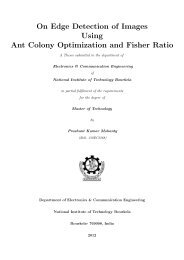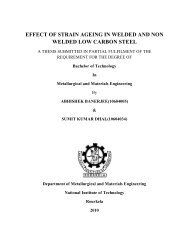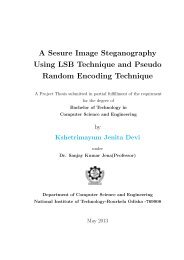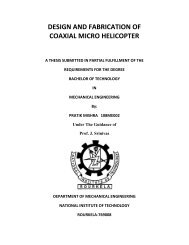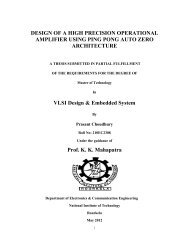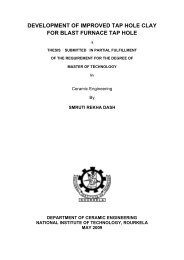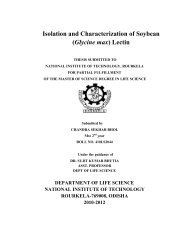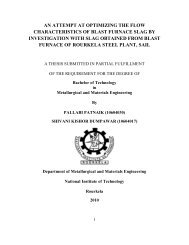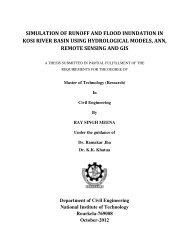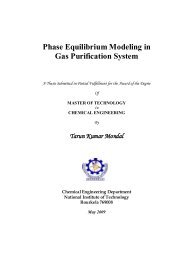analysis of transient heat conduction in different geometries - ethesis ...
analysis of transient heat conduction in different geometries - ethesis ...
analysis of transient heat conduction in different geometries - ethesis ...
You also want an ePaper? Increase the reach of your titles
YUMPU automatically turns print PDFs into web optimized ePapers that Google loves.
direction. When no s<strong>in</strong>gle and dom<strong>in</strong>ate direction for the <strong>heat</strong> transfer exist, the <strong>conduction</strong><br />
problem needs to be solved by more than one dimensions.<br />
A particular <strong>conduction</strong> circumstances also depends upon the detailed nature <strong>of</strong> <strong>conduction</strong><br />
process. Steady state means the conditions parameters such as temperature, density at all po<strong>in</strong>ts<br />
<strong>of</strong> the <strong>conduction</strong> region are <strong>in</strong>dependent <strong>of</strong> time. Unsteady or <strong>transient</strong> <strong>heat</strong> <strong>conduction</strong> state<br />
implies a change with time, usually only <strong>of</strong> the temperature. It is fundamentally due to sudden<br />
change <strong>of</strong> conditions. Transient <strong>heat</strong> <strong>conduction</strong> occurs <strong>in</strong> cool<strong>in</strong>g <strong>of</strong> I.C eng<strong>in</strong>es, automobile<br />
eng<strong>in</strong>es, <strong>heat</strong><strong>in</strong>g and cool<strong>in</strong>g <strong>of</strong> metal billets, cool<strong>in</strong>g and freez<strong>in</strong>g <strong>of</strong> food, <strong>heat</strong> treatment <strong>of</strong><br />
metals by quench<strong>in</strong>g, start<strong>in</strong>g and stopp<strong>in</strong>g <strong>of</strong> various <strong>heat</strong> exchange units <strong>in</strong> power <strong>in</strong>sulation,<br />
brick burn<strong>in</strong>g, vulcanization <strong>of</strong> rubber etc. There are two dist<strong>in</strong>ct types <strong>of</strong> unsteady state namely<br />
periodic and non periodic. In periodic, the temperature variation with time at all po<strong>in</strong>ts <strong>in</strong> the<br />
region is periodic. An example <strong>of</strong> periodic <strong>conduction</strong> may be the temperature variations <strong>in</strong><br />
build<strong>in</strong>g dur<strong>in</strong>g a period <strong>of</strong> twenty four hours, surface <strong>of</strong> earth dur<strong>in</strong>g a period <strong>of</strong> twenty four<br />
hours, <strong>heat</strong> process<strong>in</strong>g <strong>of</strong> regenerators, cyl<strong>in</strong>der <strong>of</strong> an I.C eng<strong>in</strong>es etc. In a non-periodic <strong>transient</strong><br />
state, the temperature at any po<strong>in</strong>t with<strong>in</strong> the system varies non-l<strong>in</strong>early with time. Heat<strong>in</strong>g <strong>of</strong> an<br />
<strong>in</strong>got <strong>in</strong> furnaces, cool<strong>in</strong>g <strong>of</strong> bars, blanks and metal billets <strong>in</strong> steel works, etc. are examples <strong>of</strong><br />
non-periodic <strong>conduction</strong>.<br />
1.4 HEAT CONDUCTION PROBLEMS<br />
The solution <strong>of</strong> the <strong>heat</strong> <strong>conduction</strong> problems <strong>in</strong>volves the functional dependence <strong>of</strong> temperature<br />
on various parameters such as space and time. Obta<strong>in</strong><strong>in</strong>g a solution means determ<strong>in</strong><strong>in</strong>g a<br />
temperature distribution which is consistent with conditions on the boundaries.<br />
1.4.1 One Dimensional <strong>analysis</strong><br />
In general, the flow <strong>of</strong> <strong>heat</strong> takes place <strong>in</strong> <strong>different</strong> spatial coord<strong>in</strong>ates. In some cases the <strong>analysis</strong><br />
is done by consider<strong>in</strong>g the variation <strong>of</strong> temperature <strong>in</strong> one-dimension. In a slab one dimension is<br />
considered when face dimensions <strong>in</strong> each direction along the surface are very large compared to<br />
the region thickness, with uniform boundary condition is applied to each surface. Cyl<strong>in</strong>drical<br />
<strong>geometries</strong> <strong>of</strong> one-dimension have axial length very large compared to the maximum <strong>conduction</strong><br />
3





